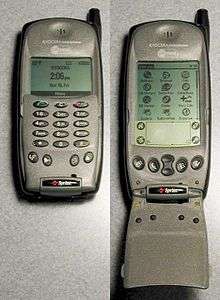Kyocera 6035
 Kyocera QCP 6035 (United States - Sprint), with flip closed and open | |
| Manufacturer | Kyocera |
|---|---|
| Predecessor | Qualcomm pdQ |
| Successor | Kyocera 7135 |
| Related | Samsung SPH-i300 |
| Type | Smartphone |
| Form factor | Flip |
| Dimensions |
142 mm (5.6 in) H 64 mm (2.5 in) W 22 mm (0.87 in) D[1] |
| Weight | 208 g (7.3 oz)[1] |
| Operating system | Palm OS 3.5.2[2] |
| CPU | 20 MHz DragonBall EZ[2] |
| Memory | 8 MB[1] |
| Battery | Lithium-ion[1] |
| Data inputs | keypad, touch (resistive screen) |
| Display | 160 x 160 px, reverse backlight |
| SAR |
1.23 W/kg at the ear 0.395 W/kg when worn on body[3] |
The Kyocera 6035 was one of the first smartphones to appear in the American market, released in February 2001.
Its predecessor was built by QUALCOMM and called the PDQ 800 (and 1900), then after Kyocera acquired Qualcomm's handset division (Qualcomm Personal Electronics), they built the QCP 6035. It was one of the first phones to combine a PDA with a mobile phone.[4]
The phone appears to have a dual-software nature, with the cellphone firmware operating independently (though available through an interface) from the Palm OS system. Like most modern smartphones, the phone operations can be off while the Palm operates, and vice versa. The systems are sufficiently integrated to pass important messages and commands to each other, though the phone's operating parameters (settings, phone book, speed and voice dial, call history etc.) are configured via the Palm OS system.
The phone has physical buttons for cellphone use, arranged on a flip which covers the Palm buttons, Graffiti area, and part of the screen. The upper part of the screen shows the phone system display when the flip is closed; when the flip is open the screen switches to Palm operation. With the flip closed, phone operations are performed via the flip buttons and a side thumb wheel.
The Palm OS system benefits from the integrated cell phone by utilizing it as an attached modem. This allows the Palm to take advantage of any IP-based Palm applications, such as email clients and web browsers.[4] The phone can also be used as an external modem for a computer via the HotSync cradle.
The phone can receive SMS messages, but earlier firmware revisions did not come with a mechanism to send them. It is WAP capable, but not MMS capable.
The 6035 comes with 8 MB of Palm memory and is not expandable. The display resolution of the 6035 is 160x160 pixels. It can perform HotSync and IR communication just as a normal Palm.
The QCP6035 won several awards at the time, including:
- CDMA Development Group's 3G Industry Achievement Award for Subscriber Technology, 2001[5]
- MobileFocus Award in the mobile phone category at the PC Expo show, 2001[6]
Different versions of the phone were made available for different CDMA wireless networks, eventually being released in Canada on Bell Mobility in late 2001.[7] (It was never made for GSM).
The successor to the 6035 was the Kyocera 7135.
References
- 1 2 3 4 "QCP 6035 Brochure" (PDF). Kyocera Wireless. April 2001. Archived from the original (PDF) on 12 June 2001. Retrieved 1 February 2015.
- 1 2 Gade, Lisa (May 2001). "Kyocera QCP 6035 Palm OS Smartphone". MobileTechReview. Retrieved 1 February 2015.
- ↑ "The Kyocera Smartphone User's Guide" (PDF). Kyocera Wireless. 2001. Archived from the original on June 12, 2001. Retrieved 1 February 2015.
- 1 2 Kellner, Mark A. (18 January 2001). "Kyocera Rings In a New Marriage of Convenience". Los Angeles Times. Retrieved 1 February 2015.
- ↑ "Kyocera's QCP 6035 Smartphone Receives 3G Industry Achievement Award from the CDMA Development Group" (Press release). Kyocera. 13 June 2001. Retrieved 1 February 2015.
- ↑ "Kyocera's QCP 6035 Smartphone Earns Inaugural MobileFocus Award in Mobile Phone Category" (Press release). Kyocera. 26 June 2001. Retrieved 1 February 2015.
- ↑ Conabree, Dave (8 November 2001). "Kyocera QCP-6035 Smartphone". The Globe and Mail. Toronto. Retrieved 1 February 2015.
External links
- "the kyocera smartphone series". Kyocera Wireless. 2001. Archived from the original on 4 March 2001. Retrieved 1 February 2015.